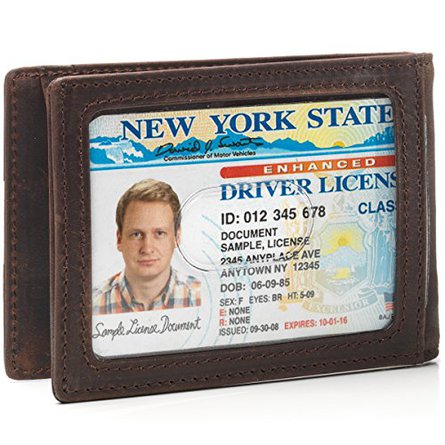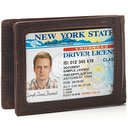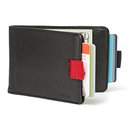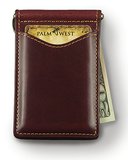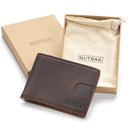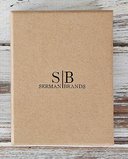What to Consider when Deciding on a Bifold Money Clip Wallet
What do you look for in a wallet? Do you want the most well-made, most durable wallet or do you just want to pick one up on the cheap and use it for a couple of years until it falls apart? Do you judge a wallet by its style or how convenient the pockets are to use?
Below, we’ll show you how we evaluate a wallet and give you some pointers on how to see past the marketing speak that companies use to shine a more positive light on their products than they actually warrant.
First, we’ll discuss how you can determine the quality of leather a wallet is made of and then the secondary materials that hold a wallet together or add features to the product. These include the stitching, money clip, lining, ID windows, and other components. Finally, we’ll talk about examining the craftsmanship of a wallet, its features and capacity, and some warranty and pricing factors to be aware of.
After you familiarize yourself with the following factors, you’ll be able to judge the quality of any leather wallet and have the confidence of knowing exactly what you’re buying.
Materials
The materials that make a bifold money clip wallet are the best indicator of how long you can expect it to last. It makes the difference between a wallet lasting 100 years or 2. Here, we’ll dive into leather quality as well as some leather alternatives and then give a brief overview of the secondary materials that might be in a wallet.
Leather Quality
To start, let’s talk about genuine leather. Genuine leather is the best, right? That’s how you know it’s real leather – not fake – because it says it’s genuine.
Unfortunately, genuine leather is one of the worst grades of leather. It’s a very common grade because it’s inexpensive to make. And it is leather. It’s made from animal hide. But it’s made from the least durable part of the hide. It’s made from the under layers. You can think of it as the bottom layers of your skin. It’s soft. It doesn’t have the feel of the top layers.
Genuine leather is often called split leather because the bottom layers are split from the top. If you have leather shoelaces, they’re probably made from genuine leather. If you have a suede jacket, it’s made from those same bottom layers of hide.
Do leather shoelaces or suede sound like a good material to make a wallet out of? Of course not! The material is too thin and doesn’t have the resiliency of top layer leather. So, how do manufacturers make wallets out of bottom layer leather?
They coat the wallets in polyurethane to give it a harder exterior. That would be an acceptable solution except that the polyurethane doesn’t last much longer than the genuine leather would on its own. The coating dries out and cracks after a year or two. It might even start peeling away from the genuine leather underneath. What you’re left with is an unattractive wallet that will quickly stretch and wear out.
So, if genuine leather doesn’t make for a durable wallet, what should you be looking for? Bonded leather? It’s bonded, so it will be stronger than genuine leather, right?
That’s the assumption marketers want you to make, but it isn’t true. Bonded leather is an even lower grade than genuine. It’s bonded, so to speak, because it’s scraps of genuine leather glued back together. It should be called recycled leather or salvaged leather. It has the same polyurethane topcoat but will wear out faster than genuine leather.
If those types of leather are the only ones you’ve heard of, that’s because they’re the most common in department stores. The material is cheap and easy to work with. Manufacturers know that they can price products made of genuine leather higher than what they’re worth because most people don’t know what genuine and bonded actually mean in terms of leather. In other words, consumer ignorance means more profit on a cheap product.
What you should actually be looking for is full-grain or top-grain leather. It is more expensive than genuine leather, but not as much as you might think, and it will last 50 times as long.
Full and top-grain leather is made from the top layers of hide. They’re actually the same material with more or less processing. Full-grain leather undergoes the least amount of processing. That means it’s the most authentic. When you look at a piece of full-grain leather, you’ll see the real hide of the animal: its pores, skin creases, birthmarks, color variations, scars, branding marks, mosquito bites. You’ll also feel the texture of the hide. Every piece is unique. If you like rugged, you’ll probably like full-grain leather.
Some people don’t like the look of full-grain leather. They need something a little cleaner with a more polished look. That’s what top-grain leather is for. When a manufacturer makes top-grain, they take a piece of full-grain and lightly sand it down until they can’t see the markings and color variations or feel the texture of the pores. If they want the leather to have a texture, they can press an artificial pore pattern into it. The end result is a very uniform, fashionable piece of leather.
Full and top-grain leather is tight and durable. It can last 100 years with minimal stretching and wear. And even though it lasts 50 times longer than genuine or bonded leather, it doesn’t cost 50 times as much. You might only 3 or 5 times the price of a genuine wallet. We’ll talk more about pricing at the end of the guide after we’ve covered a few more cost factors.
But speaking of leather quality, not all material that’s called leather is leather. We’ll tell you how to tell the difference between real leather and fake, but here’s what you should know about fake leather quality; it’s the same as split leather.
Whatever it’s called (faux leather, vegan leather, koskin), it’s all some sort of fabric covered in polyurethane, and as we already mentioned, the polyurethane doesn’t last on a surface that has to bend and flex as a wallet does. On the bright side, it also costs as little as split leather.
What do you do if a manufacturer doesn’t list the type of leather the wallet is made of? If they don’t say, there’s probably a reason. Full and top-grain leather make great selling points because they’re so durable. Faux leather is a selling point to some because it’s made from animal-friendly materials. The only type of leather that isn’t a selling point is genuine and bonded leather. If a company doesn’t list the grade of leather they used, you can bet it’s split leather. They don’t want to tell you what type of leather the wallet is made of in case you know what split leather is.
Leather Tanning
You might also see companies listing what type of tanning they used. While this doesn’t play as large a part in durability, it can be helpful to know what they’re referring to.
The two primary methods of tanning are vegetable-tanning and chrome-tanning. The third type and the oldest type is brain tanning. You won’t see anyone but hobbyists advertising brain-tanned leather.
Vegetable-tanning is the second oldest method of making leather, but it isn’t as cost-effective. It takes twice as long to tan with plant-based materials than chrome-tanning. Leather that has been tanned this way will also show watermarks more easily. If it gets wet, a permanent stain will form in the shape of the watermark.
Chrome-tanning is a relatively new practice (the 1800’s) and was discovered when doctors began soaking internal sutures in chromium to make them last longer as their patients healed from surgery. It’s a faster method and, though it will still stain if it gets wet, it doesn’t stain as badly.
Leather Thickness
The second most important factor in leather’s durability is how thick it was cut. Leatherworkers don’t just split the bottom layers of the hide from the top; they also split top and bottom layers to make the leather workable. An animal hide is too thick to use its entire depth in a wallet.
It’s up to the manufacturer to cut the leather as thick or thin as they want it. Wallet makers who use full or top-grain leather usually want their products to be as durable as possible, so they’ll cut the leather as thick as possible without providing a bulky end product.
Those who use the cheaper bottom layers tend to want to save even more money by cutting each layer thinner than it should be. A sturdy wallet should have leather that’s approximately as thick as a quarter.
If you stand a wallet up, and it sags or falls, the leather is too thin.
But be careful when you test the thickness of the layers. The sturdiness and thickness of the layers might not be as they appear. If a manufacturer cuts thin layers of leather, they’ll often make up the depth with other materials, such as plastic or cardstock. Pinch the layers to feel if there are any inserts between the layers.
A cardstock or plastic insert can mean trouble for thin leather as the leather can wear through the back as it rubs on the insert.
Leather Scent
There’s only one thing that smells like leather, and that’s leather. Leather also doesn’t smell like anything else. Leather doesn’t smell like plastic or chemicals, and leather never loses its scent. You can pull a wallet you’ve had for years out of your pocket and give it a whiff. It will still smell like leather if it ever was leather.
If a leather wallet does smell like chemicals or plastic, you know it’s genuine, bonded, or some type of faux leather. You can’t smell the leather because of the heavy polyurethane topcoat. Full and top-grain leather doesn’t need to include thick finishes, so you shouldn’t have any problem picking up the leather scent from these grades.
Leather Feel
Leather should also feel like leather. It might not have a pore texture if it was buffed out, but you should still feel the texture of the material itself. If the wallet is made of genuine, bonded, or faux leather, it will most likely feel like wax or plastic due to its thick, heavy finishes.
Again, full and top-grain leather doesn’t need heavy finishes, so nothing should prevent you from feeling its natural texture.
Leather Quality Summary
Leather that doesn’t feel or smell like leather might as well not be leather. If you want a durable bifold money clip wallet that preserves the authenticity of leather, avoid bonded, genuine, or faux. Choose full-grain for rustic charm and top-grain for fashion appeal. Make sure the layers are as thick as a quarter, and if you have a choice, opt for one that’s been chrome-tanned versus vegetable-tanned.
Nylon
Even though we don’t recommend leather that feels like plastic, there are some plastic wallets that make good alternatives for bifold money clip wallets. Nylon, for example, is a durable, flexible thermoplastic that can be shaped into any design of wallet. It’s soft and fits comfortably in your pocket.
Like leather, nylon can be dyed any color and imprinted with designs. It also doesn’t stain when wet. It might not be as fashionable as leather though. People who use nylon wallets are generally very casual types. Others might keep a nylon wallet as an alternative for jogging, playing sports, or getting wet.
Nylon has the added advantage of being inexpensive without being cheap. You can buy a nylon wallet for approximately the same price as a genuine leather wallet but without the lack of durability.
Polycarbonate
The second type of thermoplastic you might find bifold money clip wallets made of is polycarbonate. It’s also durable, but not as comfortable. Wallets made of polycarbonate form hard shells that make you think twice about which pocket to put them in.
The advantages of polycarbonate wallets include crush-proof resiliency, water-resistance, and cost-effectiveness.
Construction
Now that we’ve covered the primary materials of a wallet, we need to look at the secondary materials that it will or might be composed of. A top-layer leather bifold will fall apart if the stitching or lining comes undone, and it might become unusable if one of its extra features fail. So, let’s cover examining the construction and extras of a wallet.
Stitching
The first concern in the construction of a wallet is the stitching. When you follow the lines of stitching, you should see one of two things: either there are two parallel lines running next to each other, or there is one line that crosses back and forth over itself. The patterns are called double and cross-stitching. The purpose is to reinforce the stitching so that it doesn’t loosen when you bend and flex the wallet. You don’t want a pocket coming loose because a single line of stitching couldn’t handle the stress of having another card in the pocket.
The double-stitching pattern is more common. It’s subtle. The cross-stitching pattern is more noticeable and will only be used when the wallet maker wants to make it part of the design of the wallet. They might even use a different color thread or a thicker thread to make the cross-stitching pattern stand out more.
You should also see that the ends of the threads are melted together. When they’re all melted together, they’ll keep each line of thread tight and won’t come unraveled from one another. If you see the ends of a thread tied off or looped back under itself, beware. It will be easy for the knots to come undone and the stitching to loosen.
The type of thread the manufacturer uses isn’t as important as the pattern and finishing style, but nylon and polyester threads are slightly more durable than cotton.
Lining
The material used for the lining of the pockets is important. Many budget companies use cotton. High-fashion companies use silk. Both of these materials are soft and thin. A card with a rough edge on it can rip right through them. Better alternatives include pigskin, suede (perfectly suitable for pocket linings), nylon, and polyester.
When you look down the back of the pocket, check that the stitching for the lining doesn’t cross the area where the cards go. The edge of a card can snag a stitch and loosen the lining.
Clips, Snaps, and Chain Rings
The next necessary component of a bifold money clip wallet is the clip itself. It might be a magnetic clip or a tension clip. If it’s magnet, test the strength of the magnets. Insert bills in the clip until the magnets loosen to determine its capacity. Check the stitching around the top of the clip to see that it’s securely attached to the wallet.
If it’s a tension clip, test the capacity to see many bills it will hold before it loosens. You’ll also want to check how securely it’s attached. Wiggle the clip back and forth to determine how sturdy it is. If it has a winding mechanism, tighten and loosen it a few times to evaluate the action.
If the wallet has snaps to keep it closed, test it to see how tight the snaps are. You don’t want the wallet coming open on its own. Check that the snaps are securely fastened to the wallet. Glue is not a secure fastener.
If the wallet includes a chain ring, make sure that it has a wide rim closing around both sides of the wallet material. The material should also be double-stitched around the ring to keep it in place.
Plastic and Elastic
A bifold money clip wallet might also have a plastic ID window, a quick-access elastic band around the outside, or an elastic pull-tab.
ID windows are helpful, but the plastic is susceptible to denting, puncturing, and tearing. The most durable design for an ID window is a recessed opening for the card without plastic over top of it. Alternatively, look for one that has the window on the interior of the wallet so that it will be better protected than on the outside.
If it has any type of elastic band, be aware that elastic can stretch out and fray. When it does, that feature of the wallet won’t be usable anymore. Quick-access elastic band will hang limply when they’re stretched out, and pull-tab bands that break leave you with no easy way to access that card pocket.
Zippers
A bifold money clip wallet can also include a zipper that closes the entire wallet or a smaller one for particular pockets, such as a coin pouch, key pocket, or SIM card storage.
If the wallet does have a zipper, make sure that it closes completely. If there are gaps with open teeth at the end, the zipper could pull open on its own. The zipper should also feel tight as it opens and closes. You should have to pull on it a little, showing that the teeth are making strong connections.
Because you’ll be pulling on the zipper frequently, check that the fabric around the zipper is double-stitched to the wallet. The double-stitching will ensure that it can withstand the stress of the zipper pull without pulling away from the wallet.
Construction Summary
Stitches should show a double or cross pattern, and the ends should be melted together. Avoid cotton, silk, or other easily ripped materials. Money clips and hardware should be securely attached and tested. Keep plastic protected with interior ID windows and beware of elastic that might stretch out or fray. Zippers should be tight, close completely, and be securely sewn to the wallet.
Craftsmanship
The final element of a wallet’s durability is the craftsmanship – how well the wallet makers put it together. We’ll examine the cuts and stitching lines, the finishing style of the pockets, and the corner and edge finishing styles.
Cuts and Lines
First, you should see that each and line of stitching is perfectly straight. You don’t want to see offset stitching or wavy lines in the cuts. The stitching should also be evenly spaced around all the lines. When you look at the angle of each cut and line, they should be perfectly parallel or perpendicular to every other angle of the wallet. The only exception will be corners with rounded edges or pockets with purposefully diagonal lines.
Pocket Edges
There three primary ways to finish a pocket, all of which can be done very well or very poorly. The first and most basic finishing style is the straight cut. The leather simply ends at the top of the pocket. If the leather for the pocket is thick enough, this makes a clean finish. If the leather is too thin, it sags in the middle when there aren’t any cards in the pocket. The leather should be thick enough to hold its shape without anything in the pocket.
Folded edges have material that folds over the top of the pocket and is sewn to the inside lining. If the wallet has this style of pocket, make sure that the fold extends far enough down the pocket that you won’t hit the lip of the fold when you pull your cards out. You don’t want the inconvenience of cards getting stuck on the lip or the cards wearing down the threads of the fold.
The third style has a rolled edge on the top front of the pocket. If the wallet has rollovers, feel how thick the leather is below the roll. If it feels thick, the wallet maker had to thin the material at the top to make the roll. Doing so takes skill and time. If the pocket feels thin, the rollover makes a decorative finish, but the pocket is still too thin to be durable.
Wallet Edges
The edges of a wallet should also be thinned at the sides to fold in and blend with each layer. The interior top of the wallet without any pockets should smoothly blend with the edges of the pockets at the bottom. You don’t want to look down the edge of the wallet and see large stair steps as each pocket layer is added. You also don’t want to see the raw edges of the leather. They should be turned in and sewn down.
Cheap wallet makers cover the unfinished edges with a dark resin. It smooths the sides and covers the raw sides. Unfortunately, it won’t last. It’s like coating split or fake leather with polyurethane. The resin will crack and peel, making the finish look even worse than if it was left bare.
Corners
Finally, the corners need to be thinned and folded in to make a rounded edge. The rounding helps the wallet slide into your pocket easier. Square corners catch on the edges of pockets and either crumple or wear through too quickly.
Note that we said the corners should be thinned. The width of the material should still be present. It should be pleated (bunched together) and sewn. The pleating of the “extra” material reinforces the corner.
Craftsmanship Summary
You should see straight lines and angles. Pocket edges should be cut or rolled over with thick pockets. Folded over pockets should extend far enough down the pocket for the lip not to catch cards. Edges and corners should be thinned and folded. Corners should be rounded with a pleated sewing pattern.
Warranty
Warranties, while not the main indicator, can give you some good clues about a wallet’s durability. If a wallet maker sells a genuine leather wallet with a warranty of 6 months, for instance, that should be confirmation that the wallet won’t last very much longer than 6 months. They won’t guarantee a wallet for longer than they know it will last because they don’t want to get stuck replacing wallets or refunding money when they start to fail.
A trickier tactic is to offer no-questions-asked money-back guarantees. Why don’t they ask questions or offer to fix the wallet instead of refunding your money? Because they don’t want you to ask questions, either, and they don’t want to fix their junk product. They’re betting that they can sell a cheaply made product and that a very small percentage of their customers will actually go through the hassle of asking for a refund.
If you have a high-quality wallet with a money-back guarantee, that’s different. That’s simply the company’s way of assuring you that the product is well-made. They’re so confident that you’ll like the product that they’re willing to give you your money back if you don’t.
Long warranties offer the same assurance. If a company offers a 100-year warranty, for instance, they don’t expect the children or grandchildren of their customers to come back and ask for repairs; they’ll simply assuring their customers that the wallet will last that long.
Of course, warranties don’t need to last 100 years to give us the assurance of a well-made wallet. If a warranty lasts at least a year, that’s sufficient time to use the wallet and notice any problems with the materials or craftsmanship.
Size and Weight
Most men like a bifold money clip wallet where they only need to fold the bills once. Triple folding makes the wallet too thick and reduces its overall capacity. Bifold wallets should also fit comfortably in both back and front pockets. The ideal size, therefore, is approximately 3.5 inches wide by 4.5 inches tall.
The weight of a wallet of that size should fall in the 50-100 gram range. That amount of weight should represent thick leather and a sturdy clip. It’s also light enough not to drag your pants down.
Capacity
Before you buy a new bifold money clip wallet, count up how many bills and cards you want it to hold. You might be able to reduce the contents of your wallet, but you’ll still need a wallet that can carry your essentials.
After you know what you absolutely want to carry, try filling the wallet or read a detailed review about how much it will hold. You’ll also want to study the layout of the pockets. Imagine using the wallet on a daily basis. Will it be a convenient wallet to use?
Features
A bifold wallet can include many different features. We’ve covered a few of them above, but think about what you want in a wallet. If you’re careful, many of the features can last quite a long time. Do you want it to close with a snap, zipper, or elastic band? Do you want a pull-tab or extra pockets for coins and keys? Do you want to use a chain with it?
Browse until you find the right mix of features and quality construction.
RFID Protection
We’d encourage you to include RFID protection on your list of wanted features. Any smart card, including bank and credit cards, and key access card that you have operate via radio frequency identification (RFID).
What you might not know is that you don’t have to insert or hold your card up to a reader for someone to access the information on the card. They can use a specialized scanner to read the information off your cards through the fabric of your wallet and your clothes.
RFID protection is a metallic mesh inserted behind the lining of a wallet. It blocks the radio frequencies. Just be sure that the wallet you’re buying blocks both frequencies: 13.56 MHz for financial and personal data, 125 kHz for key cards.
You can also buy wallets that only block financial and personal data frequencies or leave the protection out of some pockets if you do want to use your key cards through your wallet.
Alternatively, you can purchase RFID blocking sleeves for your cards. They’re a little cumbersome, and their added thickness can reduce the capacity of your wallet, so it’s better to get the mesh included if you can.
Design
When we talk about design in this section, we’re talking about the exterior appearance. Do you want it to be plain, have a texture, feature an imprinted design or logo?
If you do find one with a design that appeals to you, try to think about whether you’ll continue to like that design a few years from now. Will the brand still be popular enough to display it loud and proud on your wallet? Will the design get old to you?
Most of the time, plain or a classic pore texture is the best way to go.
Purchase Options
Leather can be dyed any color, so you’re not limited to the standard blacks and browns. If you find a high-quality wallet with the capacity and features that you want, check how many colors it comes in. Finding the right color can be the deciding factor between your final choices.
Again, though, consider how well the color will match your lifestyle. Your wife or girlfriend might like your hot pink leather bifold money clip wallet, but do you really want to pull it out in front of your boss?
Packaging and Gift Boxes
The last thing you want is to finally settle on a new bifold only to have it damaged in shipping. Before you buy, try to find out how the seller will send it to you. Ideally, it should come in a product box inside of a larger shipping box with protective material surrounding it.
The wallet also might come in a gift box. Not all gift boxes are the same though. What some companies call a gift box might simply be a convenient box to wrap. It’s not decorative in any way. Others package their wallets in boxes with glossy designs that don’t need to be wrapped. True gift boxes help show the value of the gift you’re giving to someone.
Price
Now, let’s talk about price. How much should a bifold money clip wallet cost you?
That depends on the quality. If you’re buying split or fake leather, the wallet shouldn’t cost more than $15. The materials to make it are inexpensive, and it probably doesn’t have any better features than a higher-quality will have.
That higher-quality wallet, then, made of full-grain or top-grain should be priced in the $40-$60 range. It will last much longer, the top layers of hide are more expensive, and tighter leather takes more time to work with. The wallet should cost even more if it has hand-thinned rollover tops.
Nylon and polycarbonate wallets can fairly fall in the $15-25 range.
So, why are some wallets more expensive even though they’re the same quality with similar features?
Branding. The company name erroneously affects the price. If a company can convince you to buy their product at a higher price because you recognize their brand name, why wouldn’t they? On the other hand, since you now know how to evaluate the characteristics of a wallet, why would you pay more for a brand name? Buy the best quality regardless of the name of the company who made it.
Conclusion
Which is the best of the 5 top bifold money clip wallet? The JBL Leatherworks model is affordable with hand-made appeal. The Distill Union Wally features the sleekest layout. The Mutbak SCIF and Serman Brands Traveler are classically fashionable, the most affordable, and the highest rated for convenience. The Palm West money clip bifold wallet is the most distinctively stylish.
